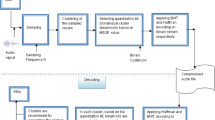Abstract
In this paper, an approach has been made to produce a compressed audio without losing any information. Separating amplitude and phase components followed by encoding individual components into suitable pattern is done in this technique. Further, binary encoding techniques are applied on these generated patterns to produce more compressed representation of audio. The encoding of amplitude is done by adaptive differential pulse-code modulation-based technique with various quantization levels considering neighbouring sampled values of a particular block. Both encoded phase and amplitude signals are represented with less volume of data. Amplitude signal is further compressed with applying Burrows–Wheeler transform and Huffman encoding technique, respectively. Experimental results are supported by statistical parameter (compression ratio) with other parameters (encoding time and decoding time) in comparison with other existing techniques to justify the efficiency of the present compression technique.





Similar content being viewed by others
References
Mondal UK (2018) A novel approach to lossless audio compression (LAC). In: 52nd annual convention of Computer Society of India (CSI 2017), January 19–21, 2018
Mondal UK, Mandal JK (2011) Songs authentication through embedding a self generated secure hidden signal (SAHS). In: The 10th international conference on computer information systems and industrial management applications (CISIM 2011), December 14–16, 2011, pp 305–313
Adjeroh D, Bell T, Mukherjee A (2008) The Burrows–Wheeler transform: data compression, suffix arrays, and pattern matching. Springer, Berlin
Sayood K (2012) Introduction to data compression, chapter 3, 4th edn. Morgan Kaufmann, Los Altos. ISBN: 9780124157965
Harada N et al (2007) MPEG-4 ALS: performance, applications, and related standardization activities. In: NTT technical review. https://www.ntt-review.jp/archive/ntttechnical.php?contents=ntr200712sp3.html
Kamamoto Y et al (2016) Transmission of high-quality sound via networks using speech/audio codecs. In: NTT technical review. https://www.ntt-review.jp/archive/ntttechnical.php?contents=ntr201611fa2.html
Huang H et al (2006) Cascaded RLS-LMS prediction in MPEG-4 lossless audio coding. In: IEEE international conference on acoustics speech and signal processing proceedings. https://doi.org/10.1109/ICASSP.2006.1661242
Gao Y (2008) Audio coding standard overview: MPEG4-AAC, HE-AAC, and HE-AAC V2. In: Mobile multimedia broadcasting standards: technology and practice, pp 607–627. https://doi.org/10.1007/978-0-387-78263-8_21
Kumbhar PY et al (2012) Sound data compression using different methods. In: ObCom 2011, part I, CCIS 269, pp 100–108. https://doi.org/10.1007/978-3-642-29219-4_12
Ravelli E et al (2009) A perceptually enhanced Scalable-to-Lossless audio coding scheme and a trellis-based approach for its optimization. In: IEEE workshop on applications of signal processing to audio and acoustics. https://doi.org/10.1109/ASPAA.2009.5346480
Wei B (2001) Enhanced CELP coding with discrete spectral modelling. In: International symposium on intelligent multimedia, video and speech processing (ISIMP 2001). https://doi.org/10.1109/ISIMP.2001.925344
Yu R et al (2006) Perceptually enhanced bit-plane coding for scalable audio. In: IEEE international conference on multimedia and expo. https://doi.org/10.1109/ICME.2006.262740
IEEE 1857.2 (2013) IEEE standard for systems of advanced audio and video coding
Ghido F et al (2013) Sparse modeling for lossless audio compression. IEEE Trans Audio Speech Lang Process 21(1):14–28
Ulacha G et al (2014) Lossless OLS–NLMS algorithm for audio coding. In: International conference on signals and electronic systems (ICSES). https://doi.org/10.1109/ICSES.2014.6948724
http://www.monkeysaudio.com/. Accessed on 29 Nov 2017 at 11 AM
http://www.wavpack.com/. Accessed on 29 Nov 2017 at 12 AM
http://nptel.ac.in/syllabus/117106090/ (chapter 1). Accessed on 30 Nov 2017 at 11:50 AM
Li Z-N, Drew MS (2004) Fundamentals of multimedia, chapter 7. Prentice Hall, Englewood Cliffs. ISBN: 0-13-127256-X
Author information
Authors and Affiliations
Corresponding author
Additional information
Publisher’s Note
Springer Nature remains neutral with regard to jurisdictional claims in published maps and institutional affiliations.
Rights and permissions
About this article
Cite this article
Mondal, U.K. Achieving lossless compression of audio by encoding its constituted components (LCAEC). Innovations Syst Softw Eng 15, 75–85 (2019). https://doi.org/10.1007/s11334-018-0321-x
Received:
Accepted:
Published:
Issue Date:
DOI: https://doi.org/10.1007/s11334-018-0321-x




